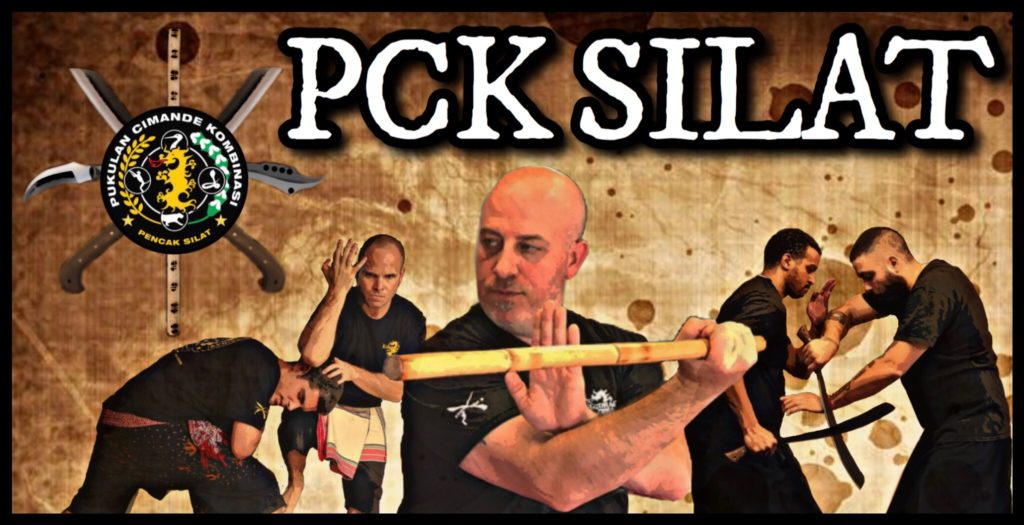PCK Ranking and Curriculum

PCK Ranking
Murid Anyar - New Student - No Sash
The Study of basic PCK Postures, Footwork, Striking, Principles, Breathing/Meditation and Kebatinan.Level 2 - Murid Satu - Beginner - White Sash
A beginner level comprehension of PCK Empty Hand and Weapons Material, Principles, Breathing/Meditation and Kebatinan.Level 3 - Murid Dua - Intermediate - Green Sash
An intermediate level comprehension of PCK Empty Hand and Weapons Material, Principles, Breathing/Meditation and Kebatinan.Level 4 - Murid Tiga - Advanced - Res Sash
An advanced level comprehension of PCK Empty Hand and Weapons Material, Principles, Breathing/Meditation and Kebatinan.Instructor Candidate Award
Completion of PCK Jurus, Animal Mannerisms and Basic Weapons. Embodies the moral code of the PCK Warrior. By receiving this rank a Pesilat is being put under consideration for our instructor ranks.Level 5 - Guru Muda- Black Sash with White Naga
Advanced Applications, Specialized Moves and Concepts drawn from PCK Jurus, Principles and Animal Mannerisms. Naga Mannerisms and internalization of the 4 Animals. Advanced understanding of the 18 PCK Principles and Advanced Weapons. Advanced Meditation/Breathing and Kebatinan. As a Guru Muda of PCK Silat you must teach to be considered for full Guru Rank.Level 6 - Guru- Black Sash with Green Naga
Completion of all PCK Material. Access to advanced Cimande, Sera and weapons training. Internalization of the 8 principles. The ability to combatively and creatively express the art as well as pass that information on to students clearly. A Guru of PCK should embody the art, its principles and the moral code of PCK Silat.Level 7 - Mas Guru- Black Sash with Red Naga
Level 8 - Pendekar- Black Sash with Silver Naga
Level 9 - Guru Besar- Black Sash with Gold Naga
Level 10 - Black Sash/Black Naga
This is a purely spiritual and meta-physical existence. It honors the original 10th degree rank from Mas Guru Agung Willy Wetzel, which includes surrendering yourself to God, consciousness and of all your worldly possessions in order to commit to a spiritual life of simplicity, solitude and samadhi.Gold Sash- PCK Achievement Award
This is the highest achievement award in PCK Silat, given to a practitioner that embodies the moral and fighting code of the Silat Warrior. This is the type of student that all others should look to as an example and one that they should strive to emulate.PCK Silat Dasar
The basic foundations of PCK material are listed below. This material is the core of PCK and is learned along side the PCK Animal material including the Monkey, Tiger, Snake, Crane and Naga and the PCK Weapons material.The 3 Assumptions of PCK Silat
- We assume there will be a minimum of 3 attackers and as many as 12 attackers will be dealt with in the later stages of training.
- We assume that ALL of the attackers will be armed with weapons.
- We assume that we will be attacked by surprise.
The 8 Attributes of PCK Silat
- Balance
- Stability
- Mobility
- Sensitivity
- Reaction
- Speed
- Power
- Timing
The 5 Ranges of Combat
- Kicking
- Striking
- Trapping
- Grappling
- Ground Fighting
The 5 Gates of Combat
- High
- Middle
- Low
- Inside
- Outside
The 8 Areas of PCK Silat
- Jurus Jurus (Upper Body)Includes all standardized upper body forms, movements and drills including: Cimande Jurus 1-33, Kelid Latihan and an Elbow Langkah.
- Langkah Langkah (Lower Body) Includes all standarized long forms and lower body movements including: Langkah Cimande, Langkah Tiga, Langkah Empat, Langkah Sarang Laba Laba, Langkah Cikalong, Langkah Garis and Langkah Kilap
- Bela Diri (Self Defense)Includes dynamic self-defense against a variety of attacks both armed and unarmed. Includes multiple opponent defenses, empty hand, strikes, grabs, holds, pushes, punches, kicks, gun, club and knife defenses.
- Sambutan (Sparring/Fighting) Refers to sparring or fighting in Pencak Silat. In PCK, the student starts with one-on-one sparring/fighting, moves to three-on-one and later up to as many as 12 opponents are dealt with. In PCK we try to emulate extreme realistic combat conditions. For this reason, sparring is taught in a methodical and progressive manner from slow to medium and finally to full contact sparring. WARNING: Protective equipment is NOT used in PCK sparring.
- Senjata (Weapons) Includes a variety of traditional Indonesian weapons and modern counterparts. Traditional weapons include: the knife, kujang, parang, kerambit and keris. Modern weapons include: pocket knife, pocket stick, machete, kerambit folder, flexible weapons and improvised weapons.
- Bunga (Flower Dance) - traditional flower dance of Pencak Silat. The movements are taught in a beautiful, fluid, rhythmic manner in the beginning to eventually become an unpredictable combative flow.Also refered to as the Crawl.
- Internal (Kebatinan/Kejawen) Includes the Sundanese teachings of Kebatinan, Kejawen and Buhun. The primary focus is the study of internal energy, the 4 elements, healing, meditation and the devepopment of rasa (intuition) to enhance your Pencak Silat training and your daily life to achieve the perfect balance of mind, body and spirit.
- Ilmu Rahasia (Secret Science) Includes advanced internal portions of the art that are only taught to the "Chosen Few" who demonstrate their dedication and devotion to the art and their teacher. Student must have a strong grasp of the Kebatinan/Kejawen training and possess unquestionable character to learn this portion of the art.
The 8 Principles of PCK Silat
- Deception: Includes Decoying, Camouflage and Stealth techniques. Making yourself appear to be vulnerable or using baits and feints to entice your opponent into a false sense of confidence. Also includes Off Timing (mental, visual and auditory) "Steal your Opponents Awareness", indirect vision and indirect hitting.
- Destruction: "Destroy or Get Out" The systematic destruction of your opponents incoming attacks beginning with Joints, Muscles and then finally Nerve Destructions. Hunting the opponents limbs (arms and legs).
- Penetration: This is the ability to close within striking range of the opponent, (taking their space) and the proper way of striking the opponent so that the target is broken, destroyed or put out of action.
- Adhesion: Sticking blows, sticking to the opponent. Once you enter the opponent’s space with the principle of penetration, you never give that space back. Includes the use of tarik (pulling) and dorong (pushing) to off-balance and sweep opponent to the ground, sticking to them the entire time, pinning them and finished with multiple strikes.
- Compacting: Utilizing your body as a weapon by collapsing one blow into another (the secret of kilap and poison hand). Small arcing blows flowing one into another with no wind-up or pulling back.
- The Thorn: The rose is a beautiful flower but when you go to grab the stem you get stuck by a thorn. The thorns of your body are your knees and elbows. When an opponent throws in a strike they will naturally get impaled by the thorns of our body.
- Bamboo: Utilizing core awareness and angulation of the body to be flexible like bamboo and help develop “Mad Rooster" and Ricochet Hitting. Bending the body to angle and give with the opponents blows, without backing up or retreating and snapping back immediately with strikes.
- Body Armor: Positioning your body to protect yourself at all times; also called “Stationing”. Always covering yourself utilizing both arms, both legs and body position in regards to your opponent. If one hand is high, then one is low, etc.
Training Realistic Combat Effectiveness
PCK Silat focuses on combative effectiveness. All of our Jurus (Entries and Striking), Langkah (Footwork), Kicking, Weapon Styles and Bela Diri (Self Defense Techniques) are based on real world application and mindfulness of multiple attackers. Most systems talk about combative effectiveness and teach drills for combat, but never really train the things that actually make students effective in combat. They are deluding their students into thinking that "because yor teacher said so" the material will magically destroy multiple attackers who have no value for your life and are probably more mentally accustomed to actual combat than you. This is putting the students at risk and wasting their time.Combative effectiveness requires a few key things:
- Realistic Material: You must train material that will actually work. The material has to be based on realistic, destructive, multiple attacker based concepts. It has to be taught from the ground up, with out shortcuts so that the student has an art based on their own fluid knowledge of the material and they are non just regurgitating a collection of techniques that will only work under certain circumstances.
- Adaptability and Non Compliant Training: That material must be trained with a non- compliant partner and must learn to be adapted to any body type or situation. Students need to know what it feels like to perform the material under stress. This also includes treating a weapon as an extension of the art. Adapting the material to fit the situation. This requires application and stress testing not just theory and "well if this were a real attacker I would do this". Non- compliant drills and sparring must be constantly trained.
- Combative Mindset: The student must learn to have a Combative Mindset. To automatically assume that you will go into some special mode of consciousness where you defeat a bunch of armed attackers is ridiculous and dangerous. This is something that must be actually trained constantly. It has to be a part of everything you train and not just theory. The mind is the most important aspect of training because if you lose control, you will lose the fight. If a student does not automatically assume that there will be multiple attackers then while he may be doing impeccable striking and technique on one attacker, he will be getting stabbed in the back by the other. This type of training helps eliminate tunnel vision in combat.
- Combative Awareness: You must learn to have Combative Awareness. Awareness of your surroundings at all times. You do not want to end up grounded against multiple attackers because you tripped over your own 2 feet. You have to learn to scan for hazards in the environment, potential places you could get cornered, look for improvised weapons, all while dealing with attackers.
- Assessing the Threat: Learn how to asses and avoid the threat all together. The ultimate goal is to not have to use force in the first place by avoiding combat all together. Learning to watch for potential threatening situations and avoid them.

Main PCK Curriculum
Cimande Jurus
The Cimande Jurus are the foundation of our art. They are learned from day 1 and are broken down into multiple categories to help students learn them more easily. The Jurus are taught at first as entries, blocking, striking and covering concepts that allow a practitioner to move in on an opponent confidently while simultaneously creating cover and destroying the opponent's limbs. Then we incorporate the concepts and principles of our animal system to allow the jurus to adapt and reach their full combative potential. In Cimande the blocks are taught first to make students comfortable with them before combining them with other concepts in the Jurus.Conditioning
- Basic PCK Stretching
- Basic Body Conditioning Exercises
- Forearm and Shin Conditioning
Rolls and Break Falls
- Forward Roll
- Backward Roll
- R and L Shoulder Roll
- Front Slapoff
- Back Slapoff
- R and L Side Slapoff
- Recovery from Falls and Rolls
Footwork
- Cimande Step
- Cimande Stepping: Front, Back, Side, Circling
- Cimande Jurus Footwork: Walking the line, Cross step
- L Footwork: L - Step and L - Retreats (variations 1 & 2)
- U Footwork
- Lankah Empat: Square Footwork
- Lankah Tiga (male/female triangles)
- PCK 8 Directional Pattern
- Cikalong Stepping
Stances / Postures
- Ready Stance
- Temple Stance
- Alert Stance
- Horse Stance (Kuda - Kuda) 3 Levels
- Cimande (Pukulan ) Stance
- Black Cobra Position
- Cross Position
- Cat Stance
- Automatic Block #1
- Automatic Block #2
- First Basic Stance
- Elbow Leading
Basic Striking
- Straight Punch
- Upper Cut
- Inverted Punch
- Hammer Fist: Forehand/Backhand
- Vertical Punch
- Back Hand Speed Punch
- Chop: Forehand/ Backhand
- Back fist
- Side Inverted Punch
- Waterfall Punch
- Cross Elbow
- Upward Elbow
- Downward Elbow
- Cobra Elbow
- Back Elbow
Striking Combinations
- PCK Striking Series
- Basic Poison Hand
- Lead Leg, Lead Hand, Back Hand, Back Leg
- Elbows and Knees
- Takedowns and Follow-Up Strikes
- Kelid Latihan
- Jurus Kombinasi
Kicking
- Front Kick
- Back Kick
- Stop Kick
- Side Kick
- Cross Kick
- Saber Kick / Inverted Saber Kick
- Cat Scratch Kick
- Toe Point Kick/ Inverted Toe Point Kick
- Dragon Tail Kick/ Inverted Dragon Tail Kick
- Falling Tiger Kick
- Shock and Shatter
Parries / Blocks
- Leaf Parries (single and double) Flower Palm
- Cimande Blocking Series
- Forearm Blocks
- Full Fist Blocks
- Elbow Hit Blocks
- Foot Parries (inside, middle, outside)
- Leg Blocks (inside, middle, outside)
Sweeps/ Throws
- Beset
- Sapu
- Shearing Throws
- The Mechanics of Throws: 3rd Point, Off Balance Points and Head Control
Bela Diri
Self Defense - Set 1 (Empty Hands Defense)- Wrist Grab Inside
- Wrist Grab Outside
- Double Wrist Grab
- Shirt Grab
- Rear Bear Hug Arms Pinned/Arms Free
- Front Bear Hug Arms Pinned/Arms Free
- Full Nelson
- Arm Bar (Hammerlock)
- 2 hand choke front (Standing, Grounded, Back against a wall)
- Rear Naked Choke
- Head Lock Front
- Head Lock Side
- Grounded Response to Full Mount
- Grounded Response to Standing Attack
- Double Leg Take Down (Tackle)
- Stick Overhead
- Stick Thrust
- Forehand Stick
- Backhand Stick
- Gun Front Low
- Gun Front High
- Gun to Back High
- Gun to Back Low
- Rifle / Shotgun to Stomach
- Rifle / Shotgun to Back Low
- Knife Slash (The Ripper)
- Knife Thrust Low
- Knife Overhead
- Knife to Throat Front
- Knife to Throat From Behind
- Combine 2 Empty hand techniques with Multiple Attackers
- Combine 1 Empty Hand and 1 Weapon technique with Multiple Attackers
- Combine 2 Weapon techniques with Multiple Attackers
- Advanced: Constant, Continuous stream of attackers
Basic Weapons
- Limbuhan: Stick- Application Based
- Pisau: Small Knife- 9 Knife Angles
- Parang: Sword- 4 Sword Forms
- Kerambit- Application Based
- Kujang- 11 Jurus
- Improvised Weapons
Bunga
A spontaneous combative flow utilizing of all of the materialInternal Training
- Breathing
- Meditation
- Tenaga Dallam: Internal Energy
- The 4 Elements and Circle of Creation
- Kebatinan
Supplemental Material
- PCK History
- The 3 Assumptions
- The 3Pillars
- The 8 PCK Principles
PCK Animal Syllabus
Animal training is broken down into four categories:- Basic Mannerisms: Covering and Blocking with the attitude of the specific animal. This teaches the attitude of the animal and how it is applicable in combat.
- Specialized Movements: Movements generally associated with the animal and those specific to the animal. These teach the function of the motions with the attitude of the animal and the jurus, strikes and concepts that are best suited for the specific animal and its attitude.
- Apply the Animal: Use of the attitude and mannerisms as a filter through which the rest of your PCK material can be seen. Applying the animal to the rest of the material such as jurus, footwork, techniques, bela diri, weapons, etc. This teaches you to apply the concepts and attitude of the animal to all of our material and to think outside of the box.
- Creating a flow: Creating a combative flow using all of the animal's movements. This teaches you to flow and mix all of your strikes and concepts together combatively. Like a boxer would shadow box to train power, precision and speed, mixing all of his skills together into a flow, you will take all of your material and make it into a flow.
THE 5 ANIMALS OF PCK SILAT

The monkey (Monyet, Kera) portion of the style uses slaps, grabs, punches and elbows, and gunting or scissors motions, changing position from high to low. It is violent and unpredictable and can adapt to any situation.

The tiger (Pamacan) utilizes a very low stance, and seeks to smash the opponents limbs and drag him down to continue the fight on the ground.The tiger also fights in a full supine (Harimau) position where the practitioner is lying fully on the ground. It is malicious and relentless and is a very thorough and effective way to deal with ground fighting. It also works against multiple attackers where grappling and locks may not.

The snake (Ular) style comes in two varieties, cobra (Sendok) and python (Sawa). The cobra style uses half-fists to deliver fast strikes to the eyes and soft body tissues, and the python attempts to strike then wrap the opponent's limbs and body to break, strangle and throw them. Snake injects poison through rapid fire, destructive striking before attempting to take down an opponent. It "hunts" the attackers limbs and incoming strikes.

The crane (Blekok) style uses high stances and leaps, together with open hand strikes. It is deceptively destructive and disguises many breaks and limb destructions in it's light motions.
And Lastly, the dragon (Raja Naga) is a synthesis of the other four animals, together with a strategy of deployment which emphasizes internal techniques and highly deceptive movements.It is a constantly changing, constantly adapting method of movement that is unpredictable and untrackable. The movements of the art are also taught according to a secret method which leads to an increase in 'tenaga dallam'(energy)in the body.



